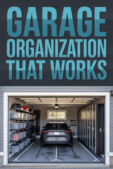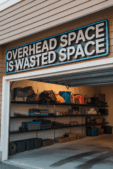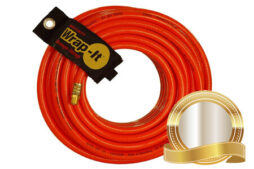7 Warning Signs Your Garage Has Officially Gone Rogue

Oh my goodness, is your garage so stuffed with random treasures that you can barely remember what color your floor is? Join the club! Most of us have turned our garages into that magical black hole where everything without a proper home mysteriously migrates. But here’s the silver lining – with a little strategy and some elbow grease (possibly literal grease if you’re like me and find 5-year-old car maintenance supplies), you can transform that chaos into an organized sanctuary that actually functions!
Wondering if your garage deserves an intervention? Look for these telltale signs:
- Your car hasn’t seen the inside of your garage since 2010
- Finding specific items requires an archaeological expedition worthy of Indiana Jones
- You’ve bought the same wrench three times because the others are playing hide-and-seek (and winning)
- Just glancing toward your garage door triggers immediate anxiety
- You’ve created precarious “storage towers” that would make structural engineers have nightmares
- You’ve mastered the art of opening the garage door just enough to slip through without revealing the chaos to neighbors
- Your once-spacious garage floor has shrunk to a single questionable pathway
If you’re nodding vigorously, it’s probably time to reclaim your garage from the clutter monsters!
The Hidden Costs of Your Cluttered Garage

Your chaotic garage is secretly stealing more than just your parking space. It’s like having a really inefficient, dusty roommate who never pays rent.
The average person loses 2.5 days annually searching for things in clutter. That’s a weekend vacation you could have taken!
Moisture and pests often damage items stored improperly, leading to unnecessary replacements.
Nothing wastes money faster than buying duplicate items because you can’t find the originals buried somewhere in your garage.
Cars parked in cluttered garages collect mysterious dents and scratches that nobody ever admits causing.
Potential homebuyers seeing your messy garage might lower their offer by thousands.
That low-grade anxiety every time you need something from the garage takes a toll on your mental wellbeing.
Tripping hazards and precariously stacked items create genuine safety concerns for your family.
Step 1: Empty and Sort Your Garage Contents

Ready for the garage equivalent of ripping off a bandaid? Let’s do this! Pick a weekend when the weather’s nice because your stuff is going to be all over your driveway.
Clear your driveway completely to create working space. You’ll need every inch.
Remove EVERYTHING from your garage and prepare for the shocking revelation of how much stuff you actually own.
Create four sorting zones: Keep (things you actually use), Store (seasonal items), Donate/Sell (good items you no longer need), and Trash/Recycle (including those mystery containers).
Be ruthlessly honest: if you haven’t used it in a year, it’s probably time for a tearful goodbye.
Group similar items together as you sort. This reveals duplicates and gives you a clear picture of what you own.
This sorting process might trigger some emotional moments – like discovering the exercise equipment you bought with such optimism years ago. Consider inviting a brutally honest friend who won’t let you keep that broken lamp you’re “definitely going to fix someday.”
Step 2: Deep Clean Your Empty Garage

With everything removed, your garage probably looks bigger than you remembered and smaller than you hoped. Now’s your chance to give it the deep clean it’s been silently begging for.
Sweep and vacuum thoroughly, removing cobwebs from corners and dust from every surface.
Wash walls and windows until they sparkle. You’ll be amazed at the difference this makes.
Inspect for any moisture issues, cracks, or evidence that critters have been having garage parties.
Consider refreshing with fresh paint – a clean, bright garage feels more inviting and organized.
Evaluate your floor – this might be the perfect time for that epoxy coating you’ve been considering.
Clean light fixtures and replace burned-out bulbs – finding things is easier when you can actually see them.
Check door seals and weatherstripping to keep pests and moisture outside where they belong.
A clean garage not only looks impressive but also protects your belongings from dust, bugs, and moisture damage.
Step 3: Create Functional Storage Zones

Before you start hauling things back in, channel your inner urban developer and plan some dedicated areas for your stuff.
Designate an Automotive Zone for your car and maintenance supplies. Remember, the garage’s primary purpose is vehicle storage!
Create a Workshop Zone where your DIY projects can come to life with tools easily accessible.
Establish a Gardening Zone for all your lawn care equipment, soil, pots, and plant care items.
Set up a Sports/Recreation Zone to keep bikes, balls, and outdoor equipment organized and ready for use.
Dedicate a Seasonal Storage Zone where holiday decorations and seasonal items can be neatly stored until needed.
Reserve space for Household Overflow to accommodate bulk purchases and rarely-used appliances.
Don’t forget a Recycling/Waste Management Zone to keep your environmental efforts organized.
Grab a measuring tape and sketch out your garage layout. Consider frequency of use – items you need often should be easily accessible, while rarely-used items can go in less convenient locations.
Wall Storage Solutions That Maximize Space

Your garage walls are prime real estate just waiting to be developed! Here are some ways to make them work harder:
Pegboards offer classic customizable solutions that make your tools visible and accessible at a glance.
Slat wall systems provide a more polished look with adjustable hooks and accessories that can be rearranged as your needs change.
Track systems with adjustable rails grow with your collection and offer flexible configuration options.
Heavy-duty hooks work wonders for hanging ladders, bicycles, and other bulky items that eat up floor space.
Magnetic strips keep metal tools handy and showcase your organizational skills while saving space.
Wire grid panels offer affordable options that make your garage look professionally organized.
When installing wall systems, always locate wall studs! Nothing ruins a good organization day like your entire system crashing down because you trusted a flimsy drywall anchor with your heavy tools.
Ceiling Storage That Defies Gravity

Look up! That ceiling space represents untapped storage potential for things you don’t need to access frequently.
Overhead storage racks transform your ceiling into usable shelving for holiday decorations, camping gear, and seasonal items.
Pulley systems make it easy to raise and lower kayaks, canoes, and other heavy sporting equipment with minimal effort.
Bicycle hoists keep bikes elevated and out of the way during their off-season, freeing up valuable floor space.
Hanging rack nets corral sports balls and lightweight equipment that otherwise resist organized storage.
Ceiling-mounted storage bins provide overhead storage without committing to a full rack system.
Important safety tip: Make sure your ceiling storage is properly anchored into joists, and save this space for lighter items – heavy objects belong elsewhere for safety reasons.
Cabinet and Shelving Systems for Concealed Storage

Some items deserve privacy (looking at you, half-empty paint cans and household chemicals):
Freestanding garage cabinets come in various materials and price points, from budget-friendly plastic to high-end wood and metal options.
Adjustable shelving units allow you to customize the height between shelves as your storage needs change.
Rolling tool cabinets bring your tools to your project, reducing the back-and-forth trips across the garage.
Wall-mounted cabinets keep floors clear while hiding visual clutter and protecting contents from dust.
Specialty storage cabinets safely store items that could stain, leak, or pose safety hazards.
Modular storage systems offer components that work together seamlessly for a cohesive look.
Consider lockable cabinets if you store anything dangerous or valuable. This keeps curious children safe and prevents expensive tools from wandering off.
Budget-Friendly DIY Garage Organization Ideas

Transform your garage without emptying your wallet with these creative solutions:
PVC pipe tool organizers provide cheap, customizable storage for long-handled tools and sports equipment.
Repurposed kitchen cabinets from renovation projects make excellent garage storage at a fraction of the cost of new units.
A wooden pallet workbench costs next to nothing but provides a solid workspace for your projects.
Coffee can small parts storage keeps nuts, bolts, and other tiny items visible and organized without special containers.
Tennis ball storage offers a quirky but effective solution for storing smaller items when cut and mounted on the wall.
Pegboard organizer panels remain a classic favorite for tool storage that’s both visible and accessible.
Upcycled drawer organizers give new life to old kitchen items by sorting and containing garage small parts.
Hardware stores often offer workshops on garage organization – attend one for inspiration and practical advice from the experts.
Tool Organization Systems That Save Time

Tools require special attention to keep them accessible, protected, and ready for action:
Tool silhouettes traced on pegboards or walls create designated “parking spaces” for each item, making it obvious when something is missing.
Mobile tool stations on rolling carts bring your tools to your project instead of making you walk back and forth.
Vertical tool storage keeps long-handled tools like rakes and shovels safely contained and easy to grab.
Small parts organization in clear containers prevents tiny items from disappearing when you need them most.
Power tool stations with charging zones keep your cordless tools ready for action when inspiration strikes.
Tool category grouping keeps similar tools together, saving time when you’re in the middle of a project.
Implementing these systems means you’ll spend more time working on projects and less time hunting for the right tool.
Solutions for Awkwardly Shaped Items

Some things just refuse to be easily organized, but these solutions can help tame even the most challenging items:
Store ladders horizontally on wall hooks to reclaim significant floor space while keeping them accessible.
Create horizontal racks for lumber and building materials to prevent warping and make selection easier.
Use wall-mounted hangers designed specifically for lawn equipment to keep these bulky items organized.
Install specialty racks for sports equipment that accommodate oddly shaped items like baseball bats and tennis rackets.
Use clear bins with detailed labels for seasonal decorations so you can quickly find what you need without opening every container.
Consider wall mounting or overhead storage for bulky outdoor furniture during the off-season.
Taking the time to find appropriate storage solutions for these challenging items prevents them from becoming floor clutter.
Car Parking Optimization Strategies

Let’s get back to the garage’s original purpose – housing your vehicle without requiring contortionist skills to enter and exit:
Install parking guides like hanging tennis balls to help you park in the optimal position every time.
Mark clear zones on the floor where no items should encroach to protect your car doors from damage.
Double-check vehicle height clearance before installing overhead storage, especially if you have roof racks.
Position frequently used items near your car door for grab-and-go convenience when you’re heading out.
Mount protective bumpers on walls to prevent door dings inside your own garage.
Use floor marking tape to create clearly defined parking spaces that eliminate guesswork.
These simple measures ensure your car fits comfortably while maintaining access to your organized storage systems.
Maintaining Your Organized Garage Long-Term

Organizing is the first step – keeping it that way requires ongoing effort:
Schedule quarterly “reset” sessions on your calendar to prevent gradual clutter creep.
Implement a strict “one in, one out” policy to prevent your garage from becoming overstuffed again.
Take “after” photos of your organized garage to motivate yourself to maintain the new systems.
Develop the habit of returning items to their designated spots immediately after use.
Create clear labels so everyone in the household knows where things belong.
Reorganize seasonally to keep currently needed items easily accessible.
These maintenance habits might seem small, but they’re the difference between a permanently organized garage and a temporary fix that slides back into chaos.
Seasonal Garage Organization Tips

Different seasons bring different storage needs. Adjust your garage organization accordingly:
In spring, move gardening tools to prime positions, service lawn equipment before you need it, and relocate winter sports gear to less accessible storage.
During summer, make pool supplies and coolers easily accessible, prepare space for garden harvest tools, and optimize ventilation to prevent heat buildup.
In fall, begin relocating summer items to their winter spots, position leaf management tools front and center, and inspect snow removal equipment before the first snowfall.
For winter, protect temperature-sensitive items from freezing, position snow shovels and ice melt where you can grab them easily, and create a spot for wet gear to dry.
This seasonal rotation keeps your garage functional year-round and prevents frustration when you need specific seasonal items.
When to Consider Professional Help

Sometimes DIY isn’t the answer, and that’s perfectly okay:
Consider professional help when your garage chaos feels overwhelming and you don’t know where to start.
If physical limitations make the project difficult or dangerous, hiring help protects your health and safety.
Professional organizers can create custom solutions for unique storage needs that don’t fit standard systems.
When previous DIY attempts haven’t yielded lasting results, an expert perspective might be what you need.
Moving into a new home presents the perfect opportunity to start with professionally designed systems.
If your schedule is too packed to complete this project in a reasonable timeframe, outsourcing makes sense.
Professional garage organizers typically charge $50-150 per hour, while complete garage systems range from $1,000-5,000. While significant, this investment can dramatically improve your daily life and potentially increase your home’s value.
A well-organized garage isn’t just about looking tidy – it’s about creating a functional space that makes your life easier. Whether you DIY or bring in professionals, transforming your cluttered garage into an organized space will reduce daily frustration and might even inspire you to tackle those projects you’ve been postponing because you couldn’t find the tools!









